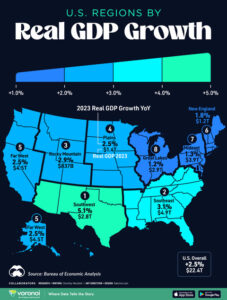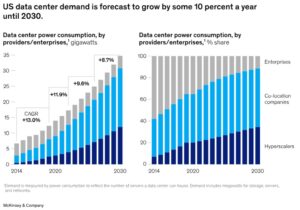
A Good Time to Live in the South!
America’s real GDP grew by 2.5 percent in 2023. That was a country-wide average. But, as you can see from this map, some areas of the country did considerably better than others.

The lowest real GDP growth in the country was seen in the Great Lakes and Mideast regions, at 1.2% and 1.3% respectively, while the greatest GDP growth took place in the Southwest and Southeast, at 5.1% and 3.1% respectively. (Map created by Visual Capitalist based on data from the Bureau of Economic Analysis.)
Chart of the Week: The Next Phase of the AI Rollout
Several weeks ago, a reader asked my thoughts about AI and State-of-the Art Robotics. These are subjects that the publishing business I’ve been consulting with for nearly 30 years writes about all the time. As investment publishers, their angle is investing – i.e., whether these technological advancements offer big profits for investors and, if so, which sectors and companies offer the greatest potential rewards.
In deference to my reader, and out of concern for my kids and grandkids, I will be writing a Special Issue on the risks and rewards of these technologies in the near future. Meanwhile, I’m grateful to Sean for taking the lead with this week’s essay. – MF
There’s been much ado about the AI rollout recently…
Especially since investors have been hearing that AI could contribute up to $15.7 trillion to the global economy by 2030.
But there’s still a lot about AI investments we do not know.
We do not know who will dominate AI software. (The winners will likely be the big tech companies, since they have the most data.)
We do not know who will dominate AI chips. (Plenty of companies are nipping at Nvidia’s heels, and companies like Google and Meta are trying to take their AI chipmaking inhouse.)
Basically, we do not yet know who will be the big winners in the AI market 10 years from now.
But we do know something for sure…
The amount of power needed to fuel the AI rollout is about to explode.

As of December 2023, there were about 10,978 data center locations in the world.
By 2030, the power consumption from these data centers and new construction is expected to double to 35 gigawatts in the US alone.
Nvidia projects that $1 trillion will be spent on data center upgrades for AI with most of the cost paid by Amazon, Microsoft, Google, and Meta.
Simply put, one of the biggest investments in the coming years will be improvements to the existing power infrastructure.
And there’s one thing we know about this aspect of the AI rollout as well…
Green energy isn’t going to cut it when it comes to data center energy needs.
A hyperscaler data center can use as much power as 80,000 households. Tech companies are already talking about building a data center that consumes as much as 1 gigawatt of power.
That’s the equivalent of 2.5 million solar panels. At 2 square meters per panel, that’s 1,235 acres of land needed to power a single one of these enormous data centers.
Not to put too fine a point on it, but there’s really only one source of energy that has the capacity to handle the energy needs we’re talking about, here…
And that’s nuclear power.
So if you want an investment idea out of all of this, look into data center REITs, utility companies that operate in nuclear-friendly regions, and uranium (miners and the commodity itself).
– Sean MacIntyre
Check out Sean’s YouTube channel here.
